2008 DODGE RAM 3500 GAS display
[x] Cancel search: displayPage 255 of 554
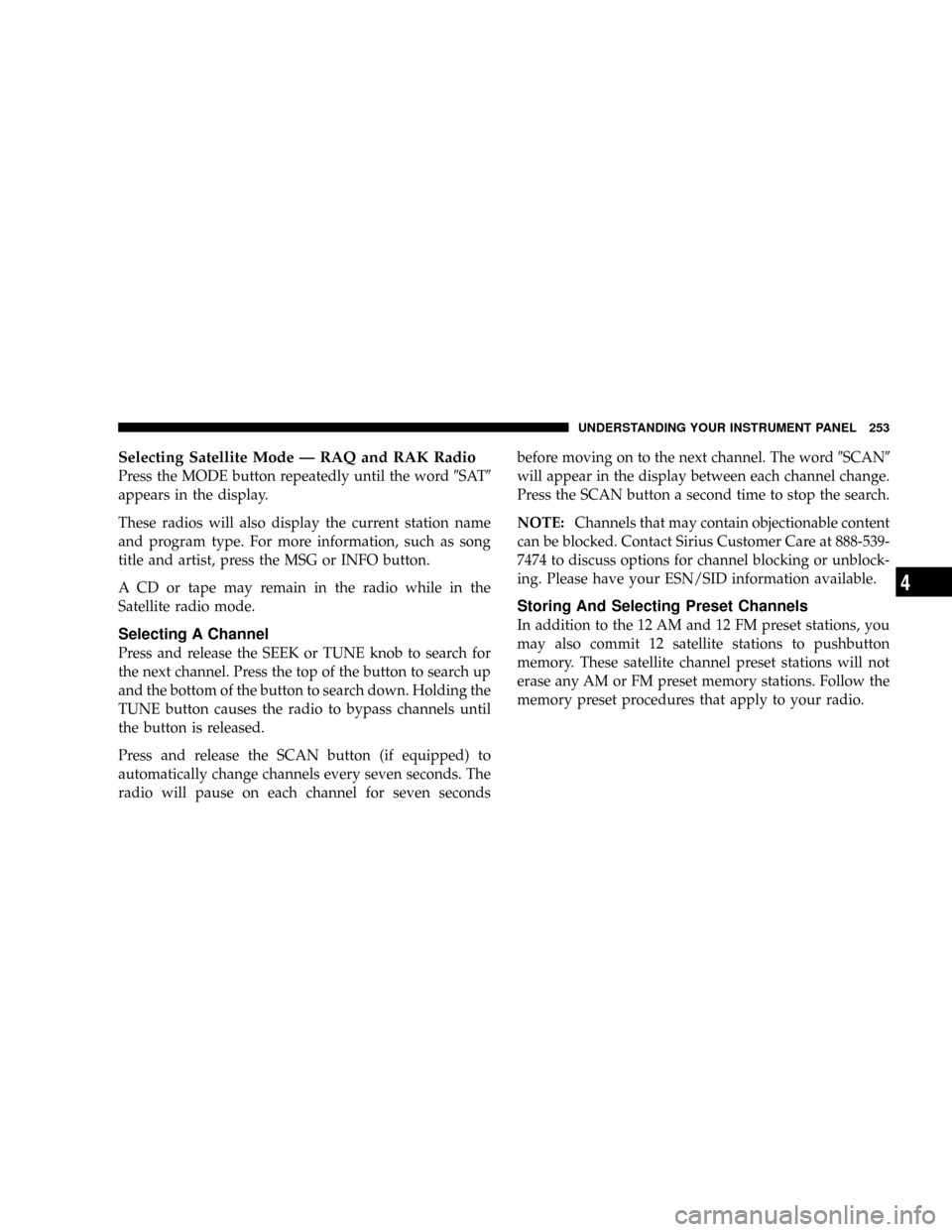
Selecting Satellite Mode Ð RAQ and RAK Radio
Press the MODE button repeatedly until the word9SAT9
appears in the display.
These radios will also display the current station name
and program type. For more information, such as song
title and artist, press the MSG or INFO button.
A CD or tape may remain in the radio while in the
Satellite radio mode.
Selecting A Channel
Press and release the SEEK or TUNE knob to search for
the next channel. Press the top of the button to search up
and the bottom of the button to search down. Holding the
TUNE button causes the radio to bypass channels until
the button is released.
Press and release the SCAN button (if equipped) to
automatically change channels every seven seconds. The
radio will pause on each channel for seven secondsbefore moving on to the next channel. The word9SCAN9
will appear in the display between each channel change.
Press the SCAN button a second time to stop the search.
NOTE:Channels that may contain objectionable content
can be blocked. Contact Sirius Customer Care at 888-539-
7474 to discuss options for channel blocking or unblock-
ing. Please have your ESN/SID information available.
Storing And Selecting Preset Channels
In addition to the 12 AM and 12 FM preset stations, you
may also commit 12 satellite stations to pushbutton
memory. These satellite channel preset stations will not
erase any AM or FM preset memory stations. Follow the
memory preset procedures that apply to your radio.
UNDERSTANDING YOUR INSTRUMENT PANEL 253
4
Page 285 of 554
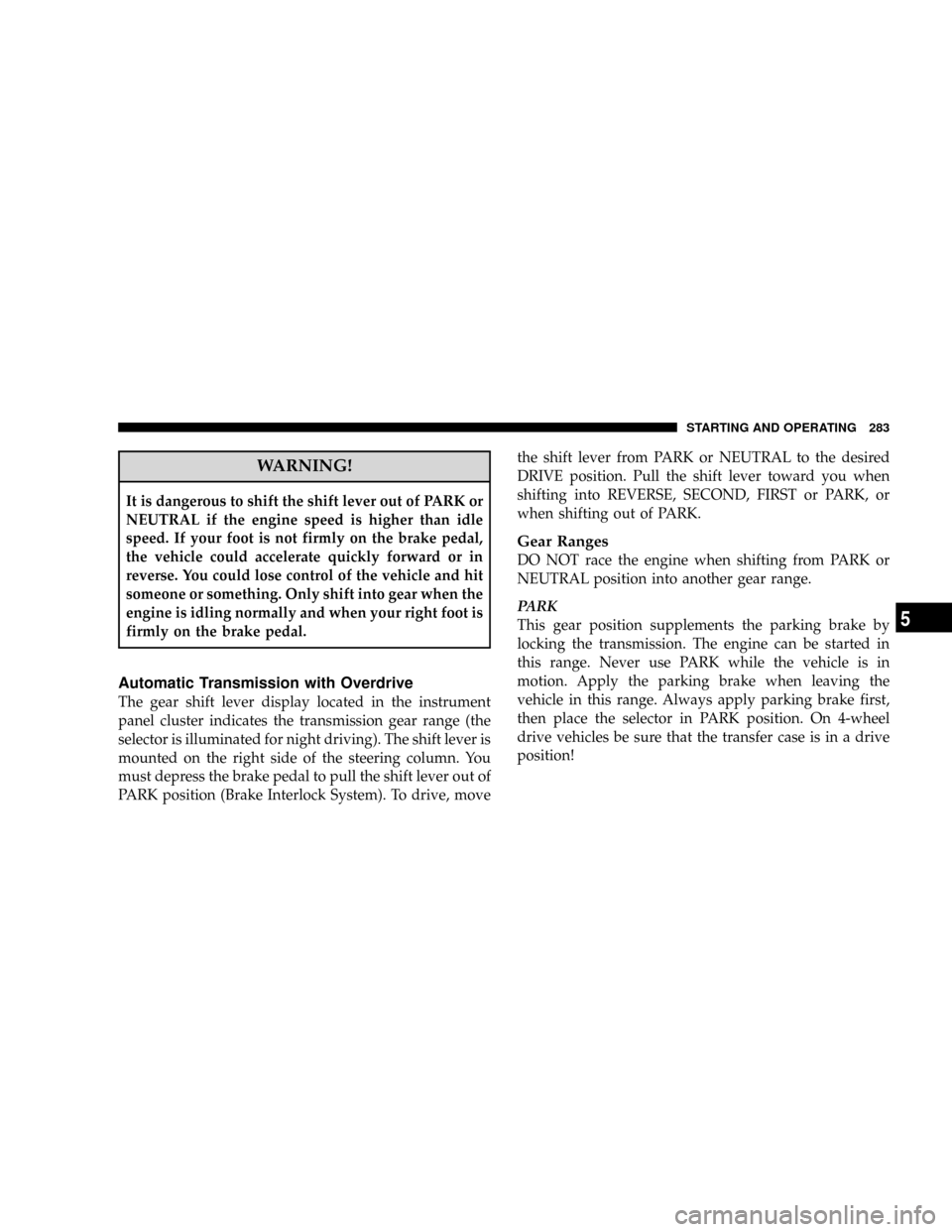
WARNING!
It is dangerous to shift the shift lever out of PARK or
NEUTRAL if the engine speed is higher than idle
speed. If your foot is not firmly on the brake pedal,
the vehicle could accelerate quickly forward or in
reverse. You could lose control of the vehicle and hit
someone or something. Only shift into gear when the
engine is idling normally and when your right foot is
firmly on the brake pedal.
Automatic Transmission with Overdrive
The gear shift lever display located in the instrument
panel cluster indicates the transmission gear range (the
selector is illuminated for night driving). The shift lever is
mounted on the right side of the steering column. You
must depress the brake pedal to pull the shift lever out of
PARK position (Brake Interlock System). To drive, movethe shift lever from PARK or NEUTRAL to the desired
DRIVE position. Pull the shift lever toward you when
shifting into REVERSE, SECOND, FIRST or PARK, or
when shifting out of PARK.
Gear Ranges
DO NOT race the engine when shifting from PARK or
NEUTRAL position into another gear range.
PARK
This gear position supplements the parking brake by
locking the transmission. The engine can be started in
this range. Never use PARK while the vehicle is in
motion. Apply the parking brake when leaving the
vehicle in this range. Always apply parking brake first,
then place the selector in PARK position. On 4-wheel
drive vehicles be sure that the transfer case is in a drive
position!
STARTING AND OPERATING 283
5
Page 338 of 554
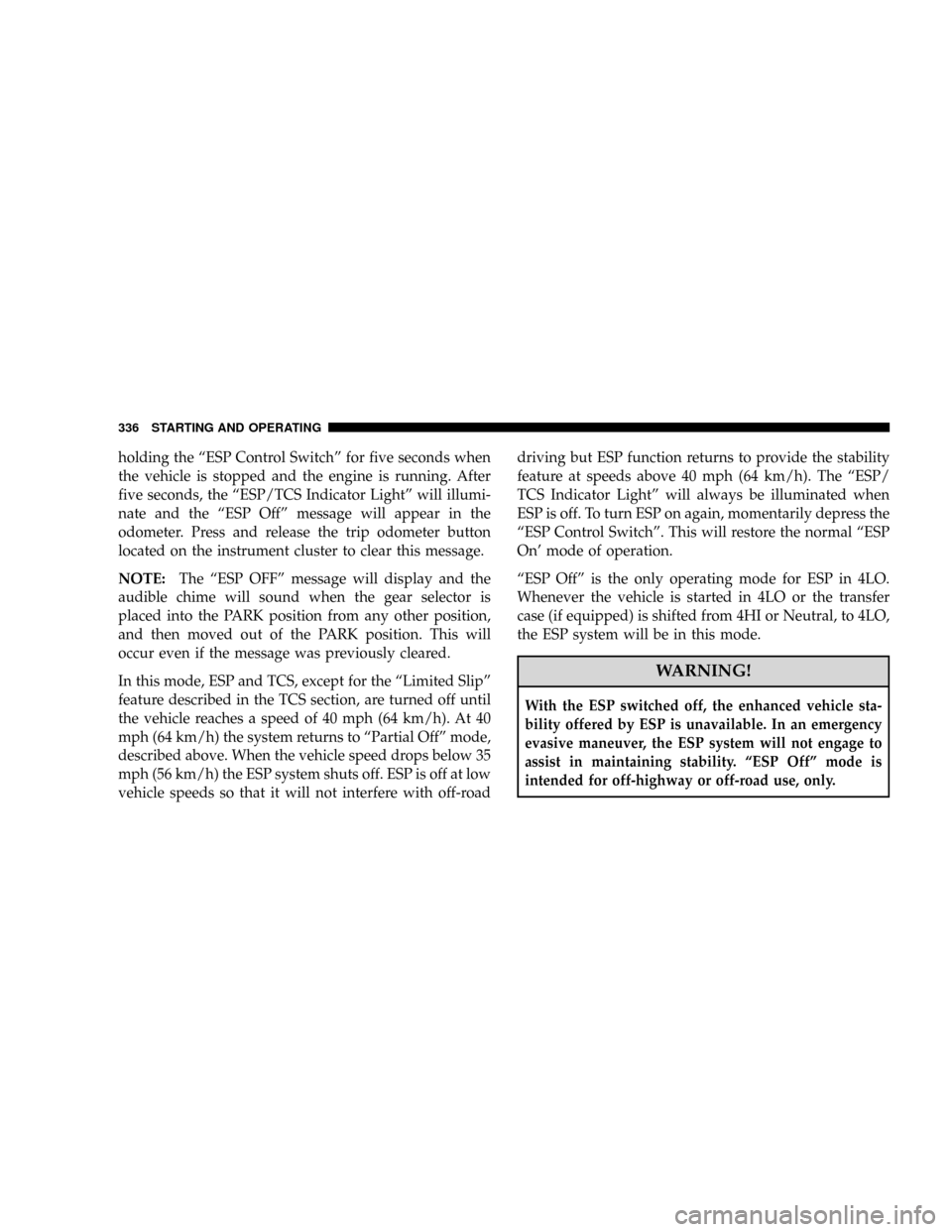
holding the ªESP Control Switchº for five seconds when
the vehicle is stopped and the engine is running. After
five seconds, the ªESP/TCS Indicator Lightº will illumi-
nate and the ªESP Offº message will appear in the
odometer. Press and release the trip odometer button
located on the instrument cluster to clear this message.
NOTE:The ªESP OFFº message will display and the
audible chime will sound when the gear selector is
placed into the PARK position from any other position,
and then moved out of the PARK position. This will
occur even if the message was previously cleared.
In this mode, ESP and TCS, except for the ªLimited Slipº
feature described in the TCS section, are turned off until
the vehicle reaches a speed of 40 mph (64 km/h). At 40
mph (64 km/h) the system returns to ªPartial Offº mode,
described above. When the vehicle speed drops below 35
mph (56 km/h) the ESP system shuts off. ESP is off at low
vehicle speeds so that it will not interfere with off-roaddriving but ESP function returns to provide the stability
feature at speeds above 40 mph (64 km/h). The ªESP/
TCS Indicator Lightº will always be illuminated when
ESP is off. To turn ESP on again, momentarily depress the
ªESP Control Switchº. This will restore the normal ªESP
On' mode of operation.
ªESP Offº is the only operating mode for ESP in 4LO.
Whenever the vehicle is started in 4LO or the transfer
case (if equipped) is shifted from 4HI or Neutral, to 4LO,
the ESP system will be in this mode.
WARNING!
With the ESP switched off, the enhanced vehicle sta-
bility offered by ESP is unavailable. In an emergency
evasive maneuver, the ESP system will not engage to
assist in maintaining stability. ªESP Offº mode is
intended for off-highway or off-road use, only.
336 STARTING AND OPERATING
Page 379 of 554
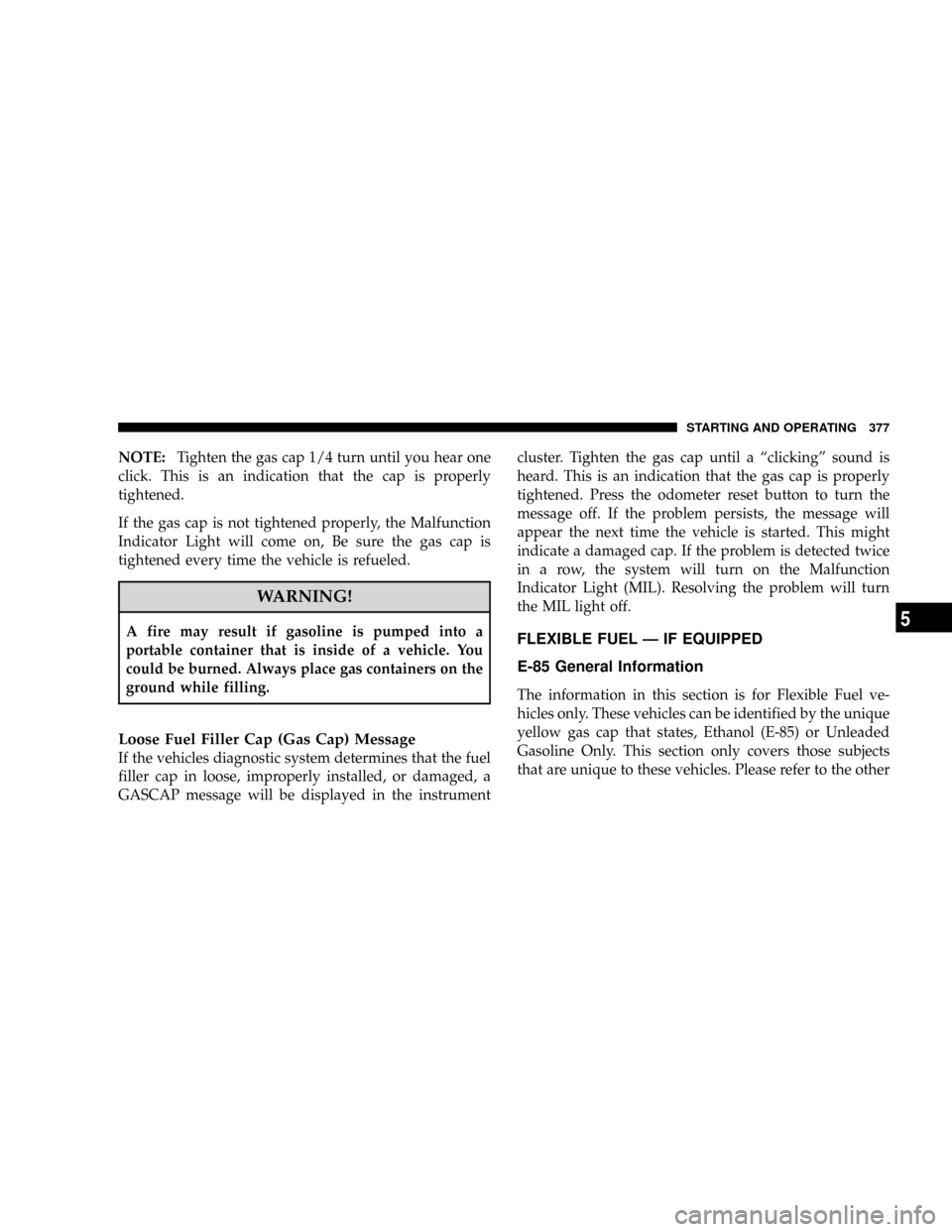
NOTE:Tighten the gas cap 1/4 turn until you hear one
click. This is an indication that the cap is properly
tightened.
If the gas cap is not tightened properly, the Malfunction
Indicator Light will come on, Be sure the gas cap is
tightened every time the vehicle is refueled.
WARNING!
A fire may result if gasoline is pumped into a
portable container that is inside of a vehicle. You
could be burned. Always place gas containers on the
ground while filling.
Loose Fuel Filler Cap (Gas Cap) Message
If the vehicles diagnostic system determines that the fuel
filler cap in loose, improperly installed, or damaged, a
GASCAP message will be displayed in the instrumentcluster. Tighten the gas cap until a ªclickingº sound is
heard. This is an indication that the gas cap is properly
tightened. Press the odometer reset button to turn the
message off. If the problem persists, the message will
appear the next time the vehicle is started. This might
indicate a damaged cap. If the problem is detected twice
in a row, the system will turn on the Malfunction
Indicator Light (MIL). Resolving the problem will turn
the MIL light off.
FLEXIBLE FUEL Ð IF EQUIPPED
E-85 General Information
The information in this section is for Flexible Fuel ve-
hicles only. These vehicles can be identified by the unique
yellow gas cap that states, Ethanol (E-85) or Unleaded
Gasoline Only. This section only covers those subjects
that are unique to these vehicles. Please refer to the other
STARTING AND OPERATING 377
5
Page 407 of 554

NOTE:During snowplow usage on vehicles equipped
with an overhead console module, the outside tempera-
ture display will show higher temperatures than the
outside ambient temperature. The higher displayed tem-
perature is due to blocked or reduced airflow to the
underhood ambient temperature sensor by the snow-
plow. This is common, and outside temperature display
operation will return to normal when the snowplow is
removed.
General Maintenance
Snowplows should be maintained in accordance with the
plow manufacturer's instructions. Whenever the plow is
disconnected from the vehicle, coat the exposed angling
cylinder rods with chassis lubricant. The lift cylinder
should be extended upward and chassis lubricant ap-
plied to the lift rod. The hydraulic hoses interconnect to
keep the couplers clean.Keep all snowplow electrical connections and battery
terminals clean and free of corrosion.
When plowing snow, to avoid transmission and driv-
etrain damage, the following precautions should be ob-
served.
²Operate with transfer case in 4L when plowing small
or congested areas where speeds are not likely to
exceed 15 mph (24 km/h). At higher speeds operate in
4H.
²Do not shift the transmission unless the engine has
returned to idle and wheels have stopped. Make a
practice of stepping on the brake pedal before shifting
the transmission between forward and reverse.
NOTE:Change the automatic transmission fluid and
filter(s), refer to ªMaintenance Scheduleº in Section 8.
STARTING AND OPERATING 405
5
Page 449 of 554
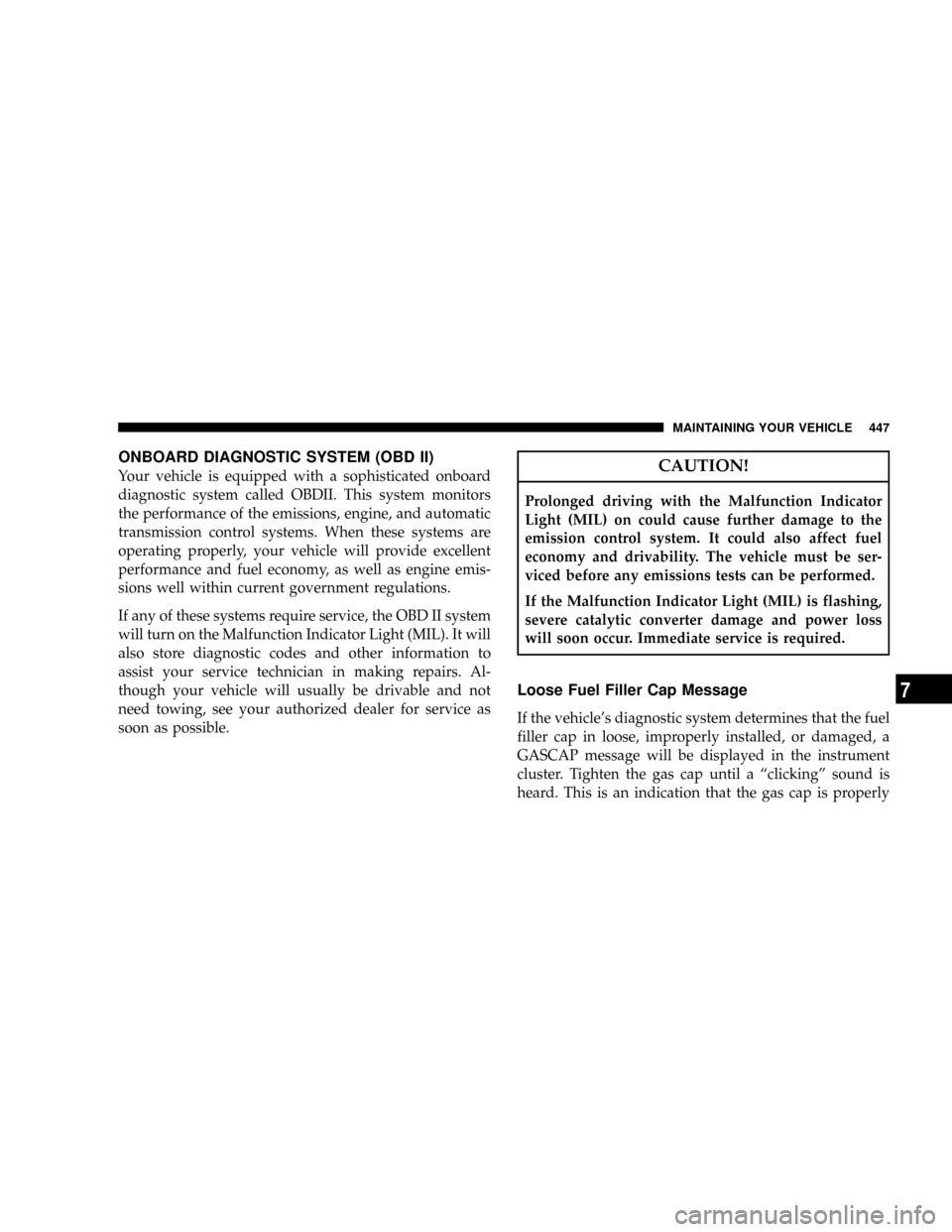
ONBOARD DIAGNOSTIC SYSTEM (OBD II)
Your vehicle is equipped with a sophisticated onboard
diagnostic system called OBDII. This system monitors
the performance of the emissions, engine, and automatic
transmission control systems. When these systems are
operating properly, your vehicle will provide excellent
performance and fuel economy, as well as engine emis-
sions well within current government regulations.
If any of these systems require service, the OBD II system
will turn on the Malfunction Indicator Light (MIL). It will
also store diagnostic codes and other information to
assist your service technician in making repairs. Al-
though your vehicle will usually be drivable and not
need towing, see your authorized dealer for service as
soon as possible.CAUTION!
Prolonged driving with the Malfunction Indicator
Light (MIL) on could cause further damage to the
emission control system. It could also affect fuel
economy and drivability. The vehicle must be ser-
viced before any emissions tests can be performed.
If the Malfunction Indicator Light (MIL) is flashing,
severe catalytic converter damage and power loss
will soon occur. Immediate service is required.
Loose Fuel Filler Cap Message
If the vehicle's diagnostic system determines that the fuel
filler cap in loose, improperly installed, or damaged, a
GASCAP message will be displayed in the instrument
cluster. Tighten the gas cap until a ªclickingº sound is
heard. This is an indication that the gas cap is properly
MAINTAINING YOUR VEHICLE 447
7
Page 496 of 554

²Any time you store your vehicle, or keep it out of
service (i.e., vacation) for two weeks or more, run the
air conditioning system at idle for about five minutes
in the fresh air and high blower setting. This will
ensure adequate system lubrication to minimize the
possibility of compressor damage when the system is
started again.
NOTE:When reinstalling the IOD fuse push firmly until
fully seated; the gauges in the instrument cluster will do
a full sweep when the ignition key is cycled to RUN. This
is a normal condition.
NOTE:
When the vehicle is shipped from the factory, the
IOD fuse is in the up, or extracted position. If the radio,
interior lamps, keyless entry, or other features do not work
with the key OFF, check the position of the fuse (or check
to see if the fuse is blown) to ensure that it is fully seated.
When the IOD fuse is extracted, the instrument cluster in
the odometer window will display9NO FUSE.º
REPLACEMENT LIGHT BULBS
LIGHT BULBS Ð Interior Bulb No.
Overhead Console Lights............... TS212-2
Dome Light............................7679
NOTE:For lighted switches, see your authorized dealer
for replacement instructions.
All of the inside bulbs are brass or glass-wedge base.
Aluminum base bulbs are not approved.
LIGHT BULBS Ð Exterior Bulb No.
Backup...............................3057
Center High Mounted Stop Light............. 912
Fog Light...........................9006LL
Headlight (Halogen)...................... H13
Side Marker, Park & Turn Signal.........3157NAK
Rear License Plate Light.................... 168
Rear Cargo Light......................... 912
494 MAINTAINING YOUR VEHICLE